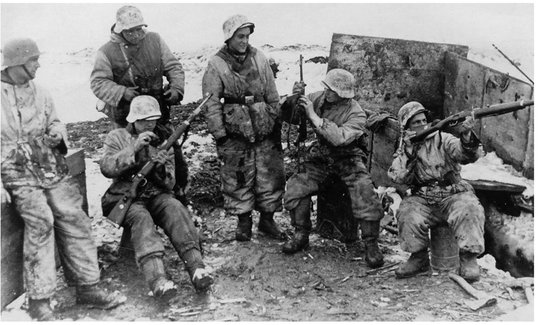Chapter Eight
Franco’s Fighting Spaniards
One of Hitler’s stranger allies on the Eastern Front was Spain. It was during the Spanish Civil War of 1936–39 that both Germany and the Soviet Union experimented extensively with armoured warfare, testing the German Panzer Mk I and the Soviet BT-5 and T-26 light tanks. In contrast, while General Franco provided Hitler with volunteers, he chose not to send any tanks to Russia.
Spain under General Franco resisted open alliance with Hitler. Franco, though, was indebted to him for considerable military aid during the civil war, so he had agreed to form a volunteer force to help fight Communist Russia–the very country that had prolonged Spain’s agony by aiding the Republicans against him. Only a unit of divisional size was called for, but forty times the number of Spaniards volunteered, such was their anti-Communist fervour.
General Agustín Muñoz Grandes and his staff flew to Berlin on 14 July 1941; the rest of the division headed for Germany via train. Understandably, passing through occupied France they were met with some hostility.Within three days they had begun to arrive at a training camp at Grafenwohr, near Bayreuth in Bavaria. The division mustered some 18,693 officers and men, consisting of the 262nd, 263rd and 269th infantry regiments supported by the 250th Artillery Regiment. Once they joined the Wehrmacht they were issued with German uniforms and equipment and designated the 250th Infantry Division. However, because of their original Falangist blue shirts, the nickname ‘Blue Division’ stuck. They were issued with German anti-tank guns but no tanks or assault guns.
The 269th Infantry Regiment was bloodied for the first time on the night of 12 October 1941. Advance positions of the 2nd Battalion at Kapella Nova caught a Soviet battalion trying to cross the river under cover of darkness. The Russians lost fifty dead and eighty PoWs in an hour’s fighting. Eight days later the 2/269th crossed the river and occupied three Russian hamlets. After throwing back determined Russian counter-attacks the 3/263rd who occupied two more hamlets reinforced the battalion.The 250th Reserve Battalion did not fare so well trying to subdue a Soviet position ominously dubbed ‘the barracks’.
When Field Marshal Von Leeb’s offensive commenced on 16 October his Panzers were trapped in a sea of mud. The Blue Division was called upon to support the southern wing of the Tikhvin drive. Kalinin had already fallen to Army Group Centre. On 8 November the Division was ordered to occupy positions 12 km east of its existing line. The 1/269th moved forward to occupy Otenski, Possad and Posselok. Four days later the Russians hurled themselves at the latter two villages. The Spanish defenders of Posselok were driven back to Possad, which in turn was surrounded. By 14 November half the defenders were dead or wounded and those still alive had to be relieved.The Russians then surrounded the monastery at Otenski on 4 December.The battle raged for four hours until the Russians were finally beaten off.
To their dismay the 1/269th found themselves re-deployed to Possad which was still under attack. That first winter the Division had to improvise snow-camouflage clothing from white sheets.While this provided a good level of camouflage against the white landscape, it provided no protection against the dropping temperature. It fell to forty below, freezing everything. When called upon to surrender, the frostbitten 1/269th at Possad defiantly yelled their civil war battle-cry ‘Arriba Espana’.
In the meantime Grandes got German permission to abandon Possad and Otenski. His men withdrew after a month of fighting to Schevelevo having suffered 120 dead, 440 wounded and twenty missing. By 10 December they had been pulled back across the Volkhov. Two days earlier Von Leeb’s Army Group North began to withdraw across the frozen Volkhov.
To the north their comrades came under attack at Udarnik and Gorka. On 27 December the village of Udarnik and the neighbouring position called the ‘Intermediate’, built between Udarnik and Lubkovo, were overrun. The Spanish defenders of Udarnik repulsed the attack, but at the ‘Intermediate’ relieving forces found their naked, mutilated compatriots strewn over the position. Every Christmas for the next two years Franco despatched a trainload of seasonal fare, including brandy and wine (guarded by the men of the elite Infantry battalion of the Ministry of the Army in Madrid) to the battered Blue Division. It was little comfort on the Eastern Front; artillery and tanks would have been a much better present.
General von Chappuis, commander of the 38th Corps decorated General Grandes with the German Iron Cross 1st Class on 6 January 1942 (he was to gain the Knight’s Cross in March 1942).The Russians on 13 January 1942 attacked across the Volkhov with the intention of linking up with the Leningrad Front.The 2nd Soviet Assault Army poured over the river, creating a pocket.
Units of the Blue Division were assigned to the German 18th Army to deal with the pocket.The 3/262nd and 250th Reconnaissance Group found themselves fighting alongside Flemish and Norwegian battalions. By the end of June the pocket had been liquidated. Colonel-General Lindemann commanding 18th Army congratulated those Spanish who had taken part having captured 5,097 PoWs and forty-six pieces of artillery.They suffered 274 casualties.
The Blue Division was then re-deployed to take part in Operation Northern Light under Field Marshal von Manstein who had just triumphed at Sevastopol. At home a plot was afoot. Grandes’ intention was to return triumphant to Spain after victory over Leningrad, and with Minister of War Carlos Asensio Cabanillas and Moroccan Juan de Yagüe Blanco force Franco to enter the war on the side of the Axis. Franco, however, replaced Foreign Minister Suner and reshuffled his Cabinet. He was beginning to worry about Grandes’ growing reputation and despatched General Emilio Esteban Infantes in June 1942 to replace him. However, Grandes now had the Führer’s ear, and Hitler agreed to designate Infantes Deputy Commander.
General Esteban Infantes arrived at Grigorovo on 8 August 1942 to take up his revised appointment. At the end of the month the Blue Division handed its sector over to the German 20th Motorised Division and headed for Vyriza south of Leningrad. It then relieved the German 121st Division in the Pushkin-Slutz zone.There were twenty Russian Divisions trapped in Leningrad by the German and Finnish Armies.The Spanish found themselves facing the 109th, 56th and 73rd Soviet infantry divisions. However, with the German disaster at Stalingrad the offensive against Leningrad was postponed.
Franco, apprehensive that either side should win, sought to extricate himself from his commitment to Hitler by seeking to mediate between the two sides.The Spanish Ambassador made Spain’s offer on 12 October 1942; Winston Churchill refused Spanish mediation and told Moscow of the move.This would have reassured Stalin that Spain intended to send no further troops to the Eastern Front.
At Krasny Bor four battalions plus supporting arms, 5,600 men of the Blue Division found themselves under attack from four Soviet infantry divisions, two armoured regiments and 187 batteries of artillery. Sources vary but this force amounted to some 44,000 men and up to 100 T-34 and KV tanks. On 10 February 1943, 800 supporting Soviet guns opened up; the bombardment accounted for half the Spanish losses that day. Infantes nearly did not make it to the battle as he was attacked on the road by four Soviet fighter-bombers. After a four-hour bombardment, ninety Soviet tanks and supporting infantry attacked the Spanish at Krasny Bor, overrunning the 2/262nd defensive positions.
Elements of the 1/262nd defending the October Railway were led by Captain Ruiz de Huidobro. Only eight days earlier he had torn up a pass to visit his newborn son in Spain. After three attacks by Soviet T-34 tanks he and his men were surrounded and overwhelmed. Only a few managed to escape toward Krasny Bor. By midday the situation was critical.
Upon entering Krasny Bor the Russians showed no mercy, firing on the hospital and escaping ambulances. Using just hand grenades and Molotov cocktails the Spanish beat off the T-34s. They were, though, forced to withdraw to the River Ishora. Then on 11 February the Soviets commenced a series of attacks on the Ishora positions. The Division had lost almost 75 per cent of its strength: of the 5,608 combatants 3,645 were casualties and another 300 had been captured. Soviet losses were estimated at 11,000.
The Spaniards spent the summer preparing for another anticipated Soviet offensive. On 5 October the Division repulsed a Russian attack, killing over 200 in what turned out to be its last major action.The Division was taken out of line leaving 2,000 comrades on the ground.They were to return to Spain and be replaced by a Spanish Volunteer Legion.They trained from Volosovo to Hof in Bavaria where they changed back into Spanish uniforms.The first draft crossed the Spanish frontier on 29 October 1943, two years after they had left.
Although the Volunteer Legion was to number only 1,000–1,500 there was no shortage of recruits.They gathered at Yamberg barracks on the Latvian frontier, under Colonel Antonio Garcia Navarro. They were pitched against the partisans operating around Narva and then sent to join the German 121st Division at Kostovo. On 24 and 25 December 1943 they beat off two Soviet attacks in the freezing cold. By the spring all German attempts on Leningrad had been thwarted and on 19 January the Legion began to withdraw under pressure from Soviet partisans into Estonia.There they were re-equipped to resist Soviet attempts on the Narva coastline. This unit was enmeshed in Army Group North’s collapse in January/February 1944.
For the Spanish the war was over, the Germans having already agreed to their repatriation. By March the legionnaires were returning home, though some chose to remain. By 17 April 1944 the majority had returned to Spain and the frontier with France was closed to would-be volunteers. Even so, 150 brave souls reached a training camp near Konigsberg, where they were joined by another 100 men who had stayed behind.These volunteers were incorporated into the Waffen-SS.
In April 1945 SS Colonel Miguel Ezquerra (a former Blue Division Captain) commanded three Spanish companies as well as some Belgian and French SS survivors. The ‘Ezquerra Unit’ fought to the last against the Russians in the devastation of Berlin, though Ezquerra himself managed to escape. When the war ended in May 1945 there were about 350 Spaniards missing or taken PoW on the Eastern Front. In total, approximately 45,000 Spaniards served on the Eastern Front, suffering some 22,000 casualties.
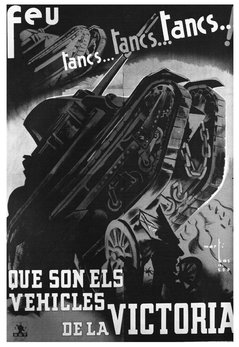
The birth of modern armoured warfare was heralded by the Blitzkrieg (Lightning War) in Poland in 1939. Just a few years earlier the European powers had cut their teeth on the art of tank warfare during the Spanish Civil War of 1936–39. Neither of the protagonists had any indigenous tank capability, forcing them to rely heavily on external supplies. This enabled Germany, Italy and the Soviet Union to cynically use the conflict as a valuable testing-ground for all manner of military hardware, but in particular artillery, aircraft and tanks. What is generally regarded as the first armoured clash of modern times took place in February 1937 during the battle at Guadalajara.
General Franco’s debt to Adolf Hitler for his support during the Spanish Civil was considerable. He repaid it by sending a volunteer infantry division to the Eastern Front. Despite being versed in armoured warfare, Franco did not send Hitler any tanks.
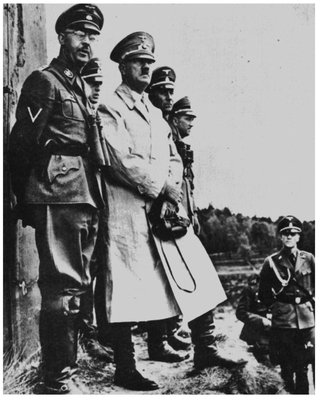
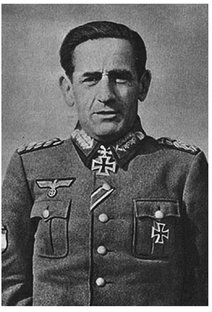
Spanish General Muñoz Grandes, commander of the Blue Division was described as a magnificent soldier and a man of great charm. He had previously served as the garrison commandant opposite Gibraltar and during the Spanish Moroccan campaigns.
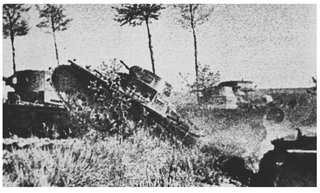
Following the Spanish Civil War Franco’s Nationalist Army was quite well-equipped with tanks, which included the German-supplied Panzer Mk I, seen here in the first shot with Soviet T-26 light tanks and on the streets of Bilbao in the second. In the early 1930s Germany designed a ‘training’ tank (after the First World War it had been banned from possessing tanks), which became the PanzerKampfwagen (PzKpfw) IA followed by the IB; in total nearly 2,500 were built.The much more numerous IB had a more powerful engine and weighed 5.7 tons, with a turret mounting two machine guns. About 200 of both types were sent to Spain, where the shortcomings of the two-man crew and lack of anti-aircraft gun soon became apparent.
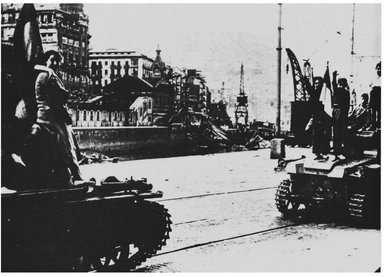
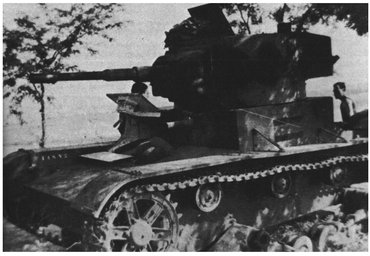
Franco also had numbers of captured Soviet T-26s (seen here) and BT-5s–1,000 had been supplied to the defeated Republican Army by Stalin.
In the 1930s the BT light fast tank was one of the principal Soviet armour types. The main model was the BT-5 (seen here, in fact a copy of the US Christie M-1931), which was equipped with a larger cylindrical turret, a 45mm gun, a co-axial MG and a larger engine than its predecessors. With a crew of three and a weight of 11.5 tons it could manage almost 70mph on the road. By the late 1930s Franco had at least 300 tanks; however, the Panzer Mk I was obsolete by 1941 and deploying the Soviet-supplied tanks to the Eastern Front would have caused no end of confusion. In addition the Spanish Army had no way of maintaining them in Russia at such an enormous distance.
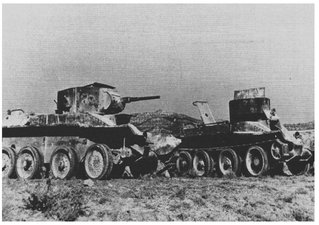
The Italians supplied Franco with several hundred L.3/33 and L.3/35 tankettes, seen here with Franco’s forces, but again this was not suitable for modern mechanised warfare in anything other than a reconnaissance or police role.
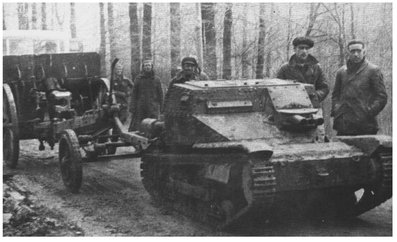
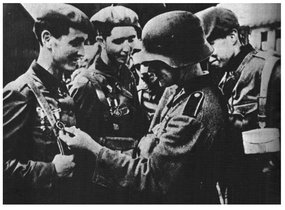
Spanish Civil War veterans show off their medals to a bemused German soldier.
Still in their Carlist berets, Spanish volunteers head off to war. Although the Spanish had hundreds of German- and Russian-built tanks, while the 250th Infantry Division included an anti-tank group it had no tank support.
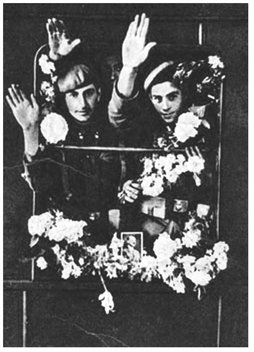
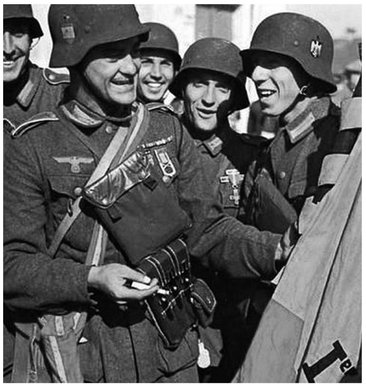
Men of the Spanish 250th Infantry Division: once they arrived at Grafenwöhr in Bavaria they were issued with German uniforms. Only the shield on their helmets and shoulder patches distinguished them as Spaniards.
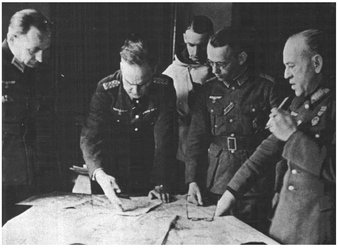
Spanish General Emilio Esteban Infantes in conference with his German counterparts in early 1943. Despite its lack of armour, his command performed well in the face of Soviet tank attacks.
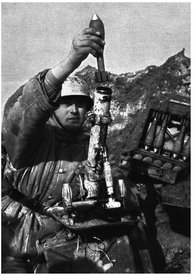
The Spanish Blue Division was equipped along the same lines as a German infantry division and was reliant on infantry support weapons such as this mortar and the 37mm anti-tank gun.
A member of the 250th Infantry Division: his España arm shield is clearly visible.
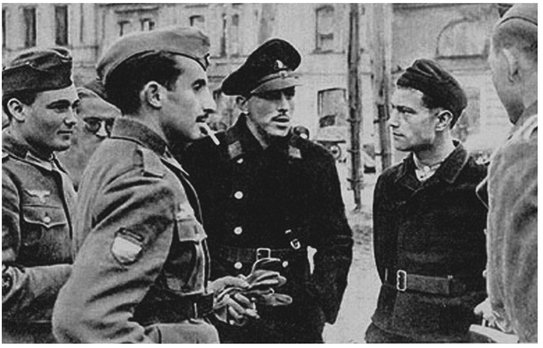
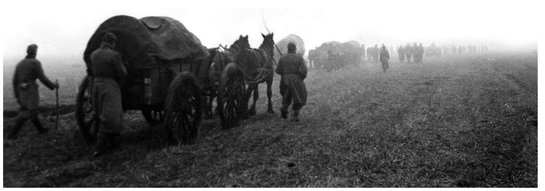
Like all the other nationalities fighting on the Eastern Front, the 250th Infantry Division relied on carts to transport much of their equipment. Although they initially deployed with 300 trucks and 400 motorcycles, these vehicles soon broke down in the face of the extreme conditions on the Russian steppe.
While the Spaniards’ artillery and anti-tank guns could cope with the Soviet T-26 light tank they struggled against the newer T-34.
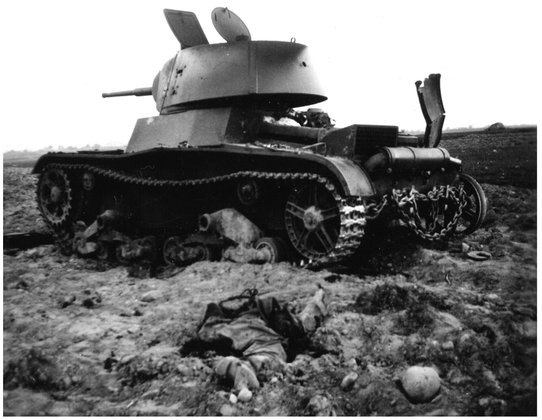
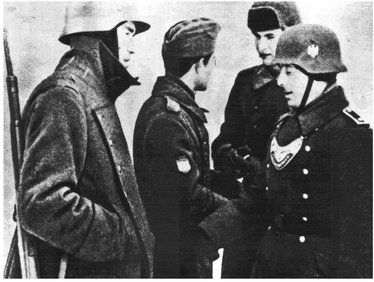
The realities of war on the Eastern Front: Blue Division members wrapped up against the cold chatting to a German military policeman.
The German infantry divisions who fought alongside the Spanish on the Leningrad Front had a high regard for their professionalism and courage.

Spanish Blue Squadron pilots stand by their Messerschmitt. The squadron clocked up a total of 136 Russian aircraft kills.
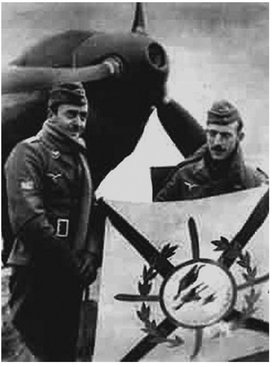
Members of the supporting Blue Squadron were issued with the standard Luftwaffe grey-blue flying uniform.
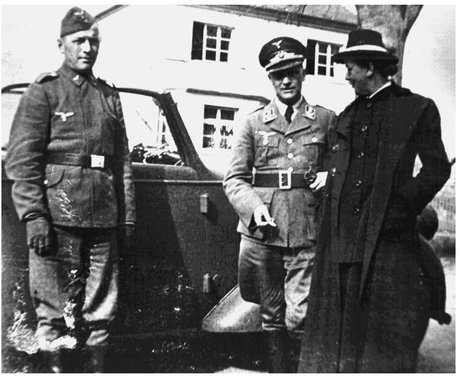
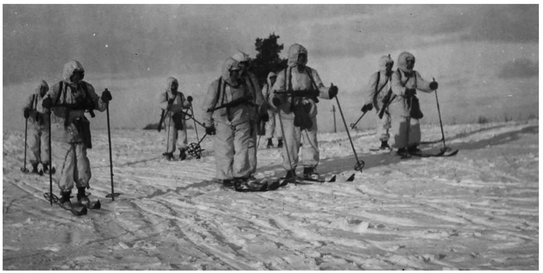
The Spanish proved quite proficient skiers. During the fighting at Krasny Bor in February 1943 the Blue Division suffered 75 per cent casualties.The Spaniards resorted to using Molotov cocktails to beat off the Soviet T-34s.
Although the 250th Infantry Division was withdrawn back to Spain in late 1943, a small volunteer unit remained in Russia and fought against Soviet partisans and the Red Army around Narva during the winter of 1943–44.
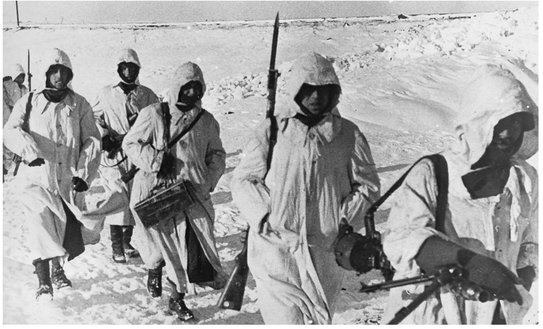
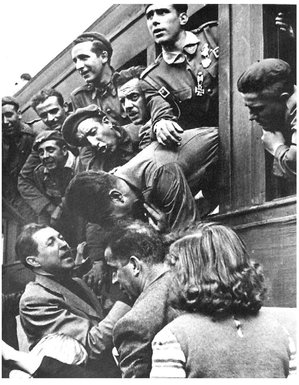
Survivors of the Blue Division come home to a warm welcome; note the man’s Iron Cross.
Time for a well-earned break and re-stock. Despite the appalling winter conditions and in the face of enemy tanks, the Blue Division fought well at such places as Possad, Udarnik and Krasny Bor.
